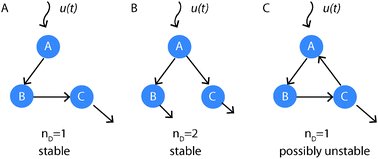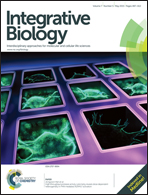Controllability analysis of transcriptional regulatory networks reveals circular control patterns among transcription factors†
Abstract
Transcriptional regulation is the most committed type of regulation in living cells where transcription factors (TFs) control the expression of their target genes and TF expression is controlled by other TFs forming complex transcriptional regulatory networks that can be highly interconnected. Here we analyze the topology and organization of nine transcriptional regulatory networks for E. coli, yeast, mouse and human, and we evaluate how the structure of these networks influences two of their key properties, namely controllability and stability. We calculate the controllability for each network as a measure of the organization and interconnectivity of the network. We find that the number of driver nodes nD needed to control the whole network is 64% of the TFs in the E. coli transcriptional regulatory network in contrast to only 17% for the yeast network, 4% for the mouse network and 8% for the human network. The high controllability (low number of drivers needed to control the system) in yeast, mouse and human is due to the presence of internal loops in their regulatory networks where the TFs regulate each other in a circular fashion. We refer to these internal loops as circular control motifs (CCM). The E. coli transcriptional regulatory network, which does not have any CCMs, shows a hierarchical structure of the transcriptional regulatory network in contrast to the eukaryal networks. The presence of CCMs also has influence on the stability of these networks, as the presence of cycles can be associated with potential unstable steady-states where even small changes in binding affinities can cause dramatic rearrangements of the state of the network.


 Please wait while we load your content...
Please wait while we load your content...